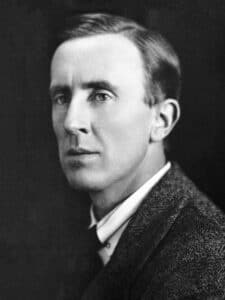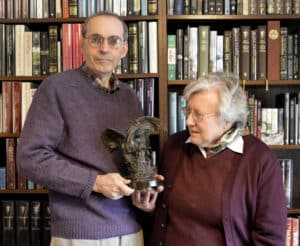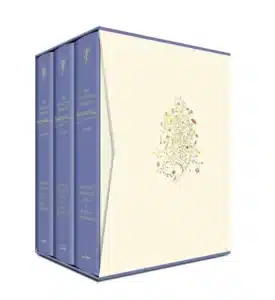Spanning 1910 to 1967, almost all of Tolkien’s poems have been collected
The first time I read The Hobbit and The Lord of the Rings (about 1970) by J.R.R. Tolkien, I committed the expected faux pas – I skipped most of the poems and songs. I was so engaged in the story itself that I wasn’t about to slow down for the poems.
When I read the books again about a decade later, I’d learned. This time, I read the poems. And the next two times, I read the poems as well, sometimes twice. I’d been educated.
The poems are more than worthwhile reading. They’re an integral part of the story, reflecting, enriching, and helping to explain the world of Middle-earth.
I saw the first notice last August, about two weeks before we were leaving for London. Tolkien’s poems had been collected. It was a three-volume set, soon-to-be published in Britain (Sept. 12) and a little later (Sept. 17) in the United States. The publisher’s list price for the boxed, three-volume set was $125. The Collected Poems of J.R.R. Tolkien. I stared in wonder.

J.R.R. Tolkien
I decided I could wait. Once we reached England, and had been there a few days, we did what we usually do, or I should say I did what I usually do. I visited a bookstore, specifically, the Waterstone’s on Trafalgar Square. (There’s also the Waterstone’s Piccadilly, said to be the largest bookstore in Europe. And Daunt Books in Marylebone, John Sandoe’s in Chelsea, Hatchard’s Piccadilly, Foyle’s on Charing Cross, Jarndyce across from the British Museum, and the bookshops on Cecil Court, off Charing Cross near St. Martin-in-the-Fields Church.) (In case you were interested.) (Oh, and Blackwell’s in Oxford.)
There at Waterstone’s-Trafalgar, I saw the Tolkien poetry set. The books were locked in a glass display case, freestanding so you could walk around it and view the books from different angles. Which I did. The price was 90 pounds (at the time, about the same as the publisher’s list price in dollars).
Temptation set in. I thought of all the reasons I should buy it right there. I could start reading immediately. I’d have it in my possession. I could spend late evenings just looking through what I could see were beautiful volumes, a work of art in themselves.
Then reality set in. I’d have to get them back to the hotel. I’d have to take them with me in my carryon bag, because no way would I risk losing them in checked baggage. I’d be toting them through Heathrow Airport, carrying them through the nightmare of the foreign arrivals’ terminal in Chicago (almost three hours), and then lugging them to the final flight home.
Sanity won out. When we finally returned home, I pre-ordered them via Amazon. The books arrived in December, a not-too-early Christmas present.
The set is a gem.

Wayne Hammond and Christina Scull
The idea for the collection started in 2016, when Christina Scull and Wayne Hammond were invited by HarperCollins to a meeting to discuss collecting and publishing Tolkien’s poems. That led to an enthusiastic response from Christopher Tolkien, literary executor for his father, and the project was born.
The editors are both Tolkien scholars, and they keep their work in the family – they’re married. They’ve published at least 10 books on Tolkien and countless articles, and their work has been recognized with several awards. She’s British, he’s American, and so represent the interest in Tolkien from both sides of the Atlantic (it should also be noted that Tolkien’s popularity is worldwide). The name of their blog is enough to warm any reader’s heart: Too Many Books and Never Enough. (I agree.)
In short, they were the ideal working team to undertake collecting the poems.
Christopher Tolkien died in 2020, so he didn’t see the final product. But by then, as Scull and Hammond note in the introduction, he’d seen enough to endorse their approach for the poems. I think he would find the final published result to be worthy of his father’s work.
The poems are organized chronologically. Volume One cover the period 1910-1919; it also includes the introduction (don’t skip it; it’s a treasury of useful information). Volume Two covers 1919-1931, and Volume Three covers 1931-1967. Thus Volume Three includes the poems of The Hobbit and The Lord of the Rings, but not all of them; Scull and Hammond selected the most important ones. Including them all would have likely required a fourth volume, and they (and the publisher) were committed to three. Volume Three also includes five appendices—limericks, Latin adages, poem lists, word lists, and a poem in Old English; and a glossary, a bibliography, and an index.
It doesn’t take long before you realize that you’re holding a major work of Tolkien scholarship. With many of the poems, Scull and Hammond discovered there were two and often several versions of the same work; they included all they found. A total of 195 poems are included in the three books, with commentary provided by the editors on each.
This is Poem No. 195, written in tribute of W.H. Auden on his 60th birthday (1967). In the 1920s, Auden had read English at Oxford; he’d heard Tolkien lecture on Beowulf and apparently had been blown away. At the time, the editors write, although a poor scholar himself, Auden had praised the lecture and the study of Old English. He also reviewed The Lord of the Rings very favorably and contributed a poem in a special book prepared for Tolkien’s 70th birthday in 1962. Tolkien reciprocated with this poem, with both Old English and contemporary English versions.
To W.H.A.

fashions verses with art; one is fluent in words,
has persuasive eloquence sound and lucid;
one is a reader of books and richly stores
his mind with memory of much wisdom
and legends of old that long ago
were learned and related by loremasters;
one is a mate to choose, a man to trust,
whose friendship’s call faithfully answers.
Another I know of noble-hearted,
to whom all these gifts in his early days
the favour of Fate freely granted.
Now wide is his renown. Wystan his name is,
as it once was also of the Waegmunding
in his far country, father of Wiglaf
most loyal of lieges, and in later time
of Wighelm’s son who in war was slain
at Byrhtnoth’s side by the Blackwater
in the famous defeat. He follows after,
and now anew that name uses
to his own honour. Auden some call him,
and so among men may he be remembered ever,
where as they sit by themselves for solace of heart
the word-lovers, wise and skilful,
revive the vanished voices of makers.
Yes, I can see that the poem was written by the same hand who wrote those great songs and poems of Middle-earth.
I could easily overuse superlatives in describing The Collected Poems of J.R.R. Tolkien. Suffice it to say it’s a treasure and a wonderful collection of poetry, coupled with informed and insightful commentary.
Just don’t make the mistake I almost made and lug it through several airports.
Related:
Photo by Lukas Schlagenhauf, Creative Commons, via Flickr. Post by Glynn Young.
How to Read a Poem uses images like the mouse, the hive, the switch (from the Billy Collins poem)—to guide readers into new ways of understanding poems. Anthology included.
“I require all our incoming poetry students—in the MFA I direct—to buy and read this book.”
—Jeanetta Calhoun Mish
- “Horace: Poet on a Volcano” by Peter Stothard - September 16, 2025
- Poets and Poems: The Three Collections of Pasquale Trozzolo - September 11, 2025
- Poets and Poems: Boris Dralyuk and “My Hollywood” - September 9, 2025


L.L. Barkat says
Oh. Wow.
You’ve convinced me. (Minus the airport, yes 🙂 )
Katie Spivey Brewster says
Thank you, Glynn once again for a superb review – and (I agree).
Bethany says
Fun and interesting piece, Glynn, thank you!
The thought of you carrying those books in your luggage makes me think of how much weight Samwise himself had to lug on his journey. 😉
So interesting to read/hear Tolkien speaking about Auden here.